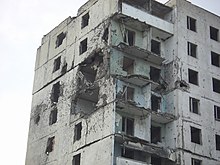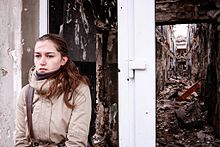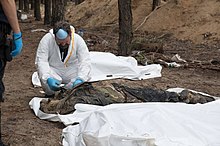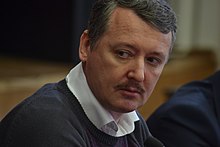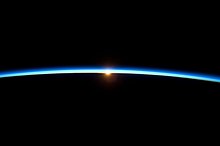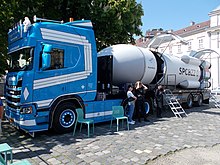From Wikipedia, the free encyclopedia
https://en.wikipedia.org/wiki/Russian_war_crimes
Russian war crimes since 1991 are the violations of the law of war, including the Hague Conventions of 1899 and 1907 and the Geneva Conventions, consisting of war crimes, crimes against humanity, and crime of genocide of which the official armed and paramilitary forces of the Russian Federation are accused of committing since the dissolution of the Soviet Union. This also extends to include aiding and abetting crimes of quasi-states or puppet states armed and financed by Russia, including Luhansk People's Republic and Donetsk People's Republic. These have included murder, the mistreatment of prisoners during interrogation (torture), deportation, abduction, looting, unlawful confinement, unlawful airstrikes or attacks against civilian objects, and rape.
Amnesty International and Human Rights Watch have recorded Russian war crimes in Chechnya, Georgia, Ukraine and Syria. Médecins Sans Frontières also documented war crimes in Chechnya. In 2017 the Office of the United Nations High Commissioner for Human Rights (OHCHR) has reported that Russia used cluster and incendiary weapons in Syria, constituting the war crime of indiscriminate attacks in a civilian populated area. On April 13, 2022, OSCE published a report finding Russia guilty of war crimes in the Mariupol hospital airstrike, while its targeted killings and enforced disappearance or abductions of civilians, including journalists and local officials, could tentatively also be crimes against humanity.
By 2009, the European Court of Human Rights (ECHR) issued 115 verdicts (including in the Baysayeva v. Russia case) finding the Russian government guilty of enforced disappearances, murder, torture, and for failing to properly investigate these crimes in Chechnya. In 2021, the ECHR also separately found Russia guilty of murder, torture, looting and destruction of homes in Georgia, as well as preventing the return of 20,000 displaced Georgians to their territory.
As a consequence of its involvement in the war in Ukraine, wide-scale international sanctions have been imposed against Russian officials in 2014, and again in 2022, by numerous countries. Russia withdrew its membership from the International Criminal Court (ICC) in 2016 when the ICC began investigating Russia's annexation of Crimea for possible violations of international law. On April 7, 2022, the United Nations General Assembly Resolution ES-11/3 suspended Russia from the UN Human Rights Council membership due to war crimes in Ukraine.
Chechnya
Following the dissolution of the Soviet Union in 1991, Chechnya declared independence from the Russian Federation. The Russian officials refused their independence declaration, sparking tensions. This ultimately escalated into a full war when 25,000 Russian soldiers crossed into Chechnya on 11 December 1994. The war ended with Chechen de facto independence and Russian troop withdrawal in 1996. The second conflict escalated again in 1999, and its counterinsurgency waged until 2009. It concluded by Russia taking full control of Chechnya and installing a pro-Russian government. Numerous war crimes were recorded, mostly by the Russian armed forces.
During the two wars, the Chechens were dehumanized and depicted by Russian propaganda as "blacks", "bandits", "terrorists", "cockroaches" and "bedbugs". The Russian armed forces perpetrated numerous war crimes.
The crimes included the following: the use of prohibited cluster bombs in the 1995 Shali cluster bomb attack, which targeted a market, a gas station and a hospital. The April 1995 Samashki massacre, where over 100 Chechen civilians were killed by OMON (riot police) forces. During the First Battle of Grozny, Russian air raids and artillery bombardments were described as the heaviest bombing campaign in Europe since the destruction of Dresden. In its report released on 26 March 1996, the United Nations Commission on Human Rights (UNCHR) accused the Russian troops of firing on and killing civilians at checkpoints and summarily executing captured Chechen men, both civilians and fighters. Two cases involved Russian soldiers murdering humanitarian aid workers who tried to save a civilian from execution on a street in Grozny. Russian Ministry of Interior forces officers fired into a group of soldiers who refused to kill the civilian population. The war caused displacement of 450,000 people, 45 percent of Chechnya's population, while 2,000 children died.
The Second Chechen War led to another round of war crimes and attacks against civilians. The 1999 Elistanzhi cluster bomb attack against civilians. The Grozny ballistic missile attack targeted a crowded market, leaving over a hundred civilians dead. The Russian Air Force perpetrated rocket attacks on a convoy of refugees trying to enter Ingushetia. This was repeated in December 1999 when Russian soldiers shot at refugees fleeing Grozny. The Alkhan-Yurt massacre and Novye Aldi massacre involved murder, looting and rape of Chechens by Russian soldiers. Staropromyslovsky massacre occurred in January 2000. The bombing of Katyr-Yurt occurred on 4–6 February 2000. The 1999–2000 siege and bombardments of Grozny caused thousands of civilians to perish.
On 17 December 1996, six delegates of the International Committee of the Red Cross (ICRC) were killed in an attack by masked gunmen at the ICRC hospital in Novye Atagi, near Grozny. In 2010, Russian special forces officer, Major Aleksi Potyomkin, claimed that the murders were perpetrated by FSB agents. A 2004 report identified Russian soldiers using rape as means of torture against the Chechens. Out of 428 villages in Chechnya, 380 were bombed in the conflicts, leaving a 70% destruction of households behind.
Amnesty International estimated that between 20,000 and 30,000 civilians have been killed in the First Chechen War alone, mostly by indiscriminate attacks by Russian forces on densely populated areas, and that a further 25,000 civilians died in the Second Chechen War. Another source assumes that 40,000–45,000 civilians were killed in the second conflict. Meanwhile, in 1996, the then Russian National Security chief Aleksandr Lebed said that 80,000 people died in the first war. Combined with the military forces, historians estimate that up to a tenth of the entire Chechen population died in the first war, a 100,000 people out of a million. Conservative estimates assume that at least 100,000–150,000 people died in the two conflicts. Higher estimates by Chechen officials and nationals assume that up to 200,000–300,000 died in the two wars. Since the start of the conflicts, there have been 57 recorded mass graves in Chechnya.
Some scholars estimated that the brutality of the Russian attacks on such a small ethnic group amounted to a crime of genocide. The German-based NGO Society for Threatened Peoples accused the Russian authorities of genocide in its 2005 report on Chechnya.
Human Rights Watch additionally recorded between 3,000 and 5,000 forced disappearances in Chechnya between 1999 and 2005, and classified it as a crime against humanity.
Georgia
Following a 7 August 2008 escalation between the break-away region of South Ossetia and Georgia, the Russian forces crossed the international border on 8 August and attacked Georgian soldiers in support of South Ossetia. Russian soldiers also crossed into the other break-away region of Abkhazia, even though no fighting was recorded there. The war ended on 12 August with a ceasefire brokered by international diplomats. The Russian government recognized South Ossetia and Abkhazia as independent countries, though some scholars described that the two regions actually became Russian protectorates.
HRW reported that no proof of intentional attacks on non-combatants by Georgian troops had been discovered.
Russia deliberately attacked fleeing civilians in South Ossetia and the Gori district of Georgia. Russian warplanes bombed civilian population centres in Georgia proper and villages of ethnic Georgians in South Ossetia. Armed militias engaged in plundering, burning and kidnappings. Attacks by militias compelled Georgian civilians to run away.
The use of cluster bombs by the Russians caused fatalities among civilians. Amnesty International accused Russia of deliberately bombarding and attacking civilian areas and infrastructure, which is a war crime. Russia denied using cluster bombs. 228 Georgian civilians perished in the conflict.
Additionally, the Russian military did nothing to prevent the ethnic cleansing of Georgians in South Ossetia in the area under its control.
Ukraine
2014–2021
Following the 2014 Ukrainian revolution, the pro-Russian Ukrainian President, Viktor Yanukovych, was ousted and fled to Russia, and the new Ukrainian government adopted a pro-European perspective. Russia responded with the annexation of Crimea, which was declared illegal by the UN General Assembly in its resolution 68/262, while pro-Russian separatists declared the unrecognized quasi-state Novorossiya, intending a secession from Ukraine, and an insurgency which eventually led to the war in Donbass, the eastern parts of Ukraine. While Russia denied its involvement in the war in Donbass, numerous pieces of evidence pointed to its support of the pro-Russian separatists. Amnesty International accused Russia of "fuelling separatist crimes" and it called upon "all parties, including Russia, to stop their violations of the laws of war".
Human Rights Watch stated that pro-Russian insurgents "failed to take all feasible precautions to avoid deploying in civilian areas" and in one case "actually moved closer to populated areas as a response to government shelling". HRW called on all sides to stop using the "notoriously imprecise" Grad rockets.
Another report by Human Rights Watch said that the insurgents had been "running amok...taking, beating and torturing hostages, as well as wantonly threatening and beating people who are pro-Kiev". It also said that the insurgents had destroyed medical equipment, threatened medical staff, and occupied hospitals. A member of Human Rights Watch witnessed the exhumation of a "mass grave" in Sloviansk that was uncovered after insurgents retreated from the city.
Insurgents with bayonet-equipped automatic rifles in the city of Donetsk paraded captured Ukrainian soldiers through the streets on 24 August, the Independence Day of Ukraine. During the parade, Russian nationalistic songs were played from loudspeakers, and members of the crowd jeered at the prisoners with epithets like "fascist". Street cleaning machines followed the protesters, "cleansing" the ground they were paraded on. Human Rights Watch said that this was in clear violation of the common article 3 of the Geneva Conventions. The article forbids "outrages upon personal dignity, in particular humiliating and degrading treatment". They further said that the parade "may be considered a war crime".
A map of human rights violations committed by the separatists, called the "Map of Death", was published by the Security Service of Ukraine (SBU) in October 2014. The reported violations included detention camps and mass graves. Subsequently, on 15 October, the SBU opened a case on "crimes against humanity" perpetrated by insurgent forces.
A mid-October report by Amnesty International documented cases of summary executions by pro-Russian forces. A report by Human Rights Watch documented use of cluster munitions by anti-government forces.
In October 2014, Aleksey Mozgovoy organised a "people's court" in Alchevsk that issued a death sentence by a show of hands to a man accused of rape.
At a press conference in Kyiv on 15 December 2015, UN Assistant Secretary-General for human rights Ivan Šimonović stated that the majority of human rights violations committed during the conflict were carried out by the separatists.
Amnesty International reported that it had found "new evidence" of summary killings of Ukrainian soldiers on 9 April 2015. Having reviewed video footage, it determined that at least four Ukrainian soldiers had been shot dead "execution style". AI deputy director for Europe and Central Asia Denis Krivosheev said that "the new evidence of these summary killings confirms what we have suspected for a long time". AI also said that a recording released by the Kyiv Post of a man, allegedly separatist leader Arseny Pavlov, claiming to have killed fifteen Ukrainian prisoners of war was a "chilling confession", and that it highlighted "the urgent need for an independent investigation into this and all other allegations of abuses". Russia's actions in Ukraine have been described as crimes against peace and crimes against humanity (Malaysia Airlines Flight 17 shoot down).
In 2019, the Ukrainian government considered 7% of Ukraine's territory to be under occupation. The United Nations General Assembly resolution A/73/L.47, adopted on December 17, 2018, mostly concurred and designated Crimea as under "temporary occupation".
The United Nations recorded that the war claimed the lives of over 3,000 civilians by 2018.
2022
On February 24, 2022, Russian forces invaded and attacked Ukraine from the north, south and east, which was interpreted as a form of extreme Russian irredentism. HRW and Amnesty International accused Russia of using imprecise cluster munitions in civilian areas, including near hospitals and schools, which constitute unlawful attacks with weapons that indiscriminately kill and maim. UN High Commissioner for Human Rights condemned Russia's military action as a violation of international law. Amnesty International labeled it an act of aggression that is a crime under international law. Numerous war crimes were recorded, including murder, torture, abductions, deportation, looting, rape against Ukrainian women, attacks on civilians, unlawful airstrikes or attacks against civilian objects, unlawful confinement, threats of violence, and inhumane treatment of POWs.
Among the targets of Russian airstrikes was Ukraine's capital Kyiv, a city of some 3 million people. Kindergartens and orphanages were also shelled. Russian forces were accused of a campaign of terror against Ukrainians. On March 3, 2022, Russian forces were reportedly looting across Kherson. During the Siege of Mariupol, the city was destroyed by shelling and cut off from electricity, food and water. A 6-year old girl was reported to have died from dehydration under the ruins of her home in Mauripol on March 8. During the assault on Irpin, the Russian forces indiscriminately fired at refugees trying to flee across a collapsed bridge. A family of four was killed by a mortar strike.
During the Battle of Kharkiv, the city was destroyed by Russian shelling, including a boarding school for blind people. Out of a population of 1.8 million, only 500,000 people remained in Kharkiv by March 7. On February 28, 2022, a Russian cluster bomb attack killed 9 civilians and wounded 37 more in Kharkiv. On 3 March, 47 civilians were killed in Chernihiv, most of whom were standing in line at a food store, waiting for bread, when a Russian air strike with eight unguided aerial bombs hit them. In the Mariupol hospital airstrike, three people were killed, including a young girl; whereas hundreds died in the Mariupol theatre airstrike, used as an air raid shelter. Following the withdrawal of Russian forces from the E-40 highway around the Kyiv area, BBC News discovered 13 dead bodies left lying on the road, only two wearing Ukrainian military uniforms. The evidence points to Russian soldiers killing these fleeing civilians.
After the Russian forces left the area of Bucha after a month of occupation, on April 1–3 photos and videos emerged showing hundreds of killed people lying on the streets or in mass graves. The event triggered an international response as it was widely covered by journalists as the Bucha massacre.
Thousands of civilians were killed by Russia's indiscriminate shelling and missiles strikes against civilian areas: in Borordianka, Kramatorsk, Vinnytsia, Chasiv Yar, Serhiivka, and others. A Ukrainian official said that Russia is using mobile crematoriums to dispose of bodies in Mariupol in an attempt to cover up evidence of war crimes and hide the number of people that have died. On 7 May 2022, the Bilohorivka school bombing killed dozens of people sheltering in the basement. Odessa was bombed continuously for months. On 15 June 2022, OHCHR expressed concerns over reports that Ukrainian children were forcibly deported to Russia, where they were being sent for rushed adoption, stating that these "do not appear to include steps for family reunification or respect the best interests of the child". UNICEF similarly declared that "adoptions should never occur during or immediately after emergencies".
Russian filtration camps were set-up to detain, interrogate and torture Ukrainians suspected to have connections with Ukrainian government. On 14 July 2022, OSCE released a report finding that Russia was guilty of murder, rape, abduction and deportations of Ukrainian civilians, including the transfer of 2,000 children from orphanages and institutions to Russia, even though many have relatives in Ukraine, which qualifies as a widespread and systematic attack against a civilian population, and is a crime against humanity.
Several scholars declared that Russia was committing genocide in Ukraine. This assertion was corroborated by a report by New Lines Institute for Strategy and Policy and Raoul Wallenberg Centre for Human Rights which inferred that Russia breached two articles of the 1948 Genocide Convention.
On 14 September, Ukrainian authorities discovered a mass grave with 440 corpses in Izium after the Russian forces withrdrew from the area. The events were described as the Izium massacre.
By March 30, the UN reported that 4 million refugees fled Ukraine, that 50 hospitals in the country were targeted, and that Russia used the banned cluster munition in at least 24 instances. Russia's attack against Ukraine forced 11.5 million people to flee their homes, sparking the largest refugee crisis of the 21st century. On April 22, the UN recorded at least 2,343 killed civilians, of which 92.3% were attributable to the Russian armed forces. By October, the UN recorded 6,306 killed civilians.
Ukrainian civilian killed during the Russian bombing of Chernihiv
Russian bombardment on the outskirts of Kharkiv
Civilians hiding in the Kyiv Metro during the 2022 assault
Syria
On 30 September 2015, Russian military intervened directly in the Syrian Civil War on the side of the pro-Russian government of Bashar al-Assad. According to Amnesty International, in late February 2016 Russian warplanes deliberately targeted civilians and rescue workers during their bombing campaign. The human rights group has documented attacks on schools, hospitals and civilian homes. Amnesty International also said that "Russia is guilty of some the most egregious war crimes" it had seen in decades. The director of Amnesty's crisis response program, Tirana Hassan, said that after bombing civilian targets, the Russian warplanes "loop around" for a second attack to target the humanitarian workers and civilians who are trying to help those have been injured in the first sortie.
In February 2016, Human Rights Watch (HRW) reported extensive use of cluster munitions by Syria and Russia, in violation of United Nations resolution 2139 of 22 February 2014, which demanded that all parties end "indiscriminate employment of weapons in populated areas". HRW said that "Russian or Syrian forces were responsible for the attacks" and that the munitions were "manufactured in the former Soviet Union or Russia" and that some were of a type that had "not been documented as used in Syria" prior to Russia's involvement in the war, which they claimed, suggested that "either Russian aircraft dropped them or Russian authorities recently provided the Syrian government with more cluster munitions, or both". HRW also noted that while neither Russia nor Syria are parties to the Cluster Munitions Convention, the use of such munitions contradicts statements issued by the Syrian government that they would refrain from using them. Russian indiscriminate bombings against civilians, using banned cluster bombs or firebombing, were often deemed as a violation of international law, mostly during the battle of Aleppo and siege of Eastern Ghouta. Several parallels were drawn between the 2016 destructions in Aleppo with those from Grozny in 2000, described by some as indicating a joint policy of "take no prisoners". Between May and July 2019, heavy Russian bombardments killed 544 civilians in the assault on Idlib. On 22 July 2019, the Ma'arrat al-Numan market bombing killed 43 civilians. On 16 August 2019, Russian fighter jets perpetrated an airstrike on Hass refugee camp, killing 20 civilians.
On 6 March 2018, the United Nations Human Rights Council published a public report confirming that the Atarib market bombing was perpetrated by the Russian military. A Russian fixed-wing aircraft using unguided weapons, including blast weapons, were used against this location. The report concluded that using such heavy weapons on densely populated civilian areas may amount to a war crime. On 2 February 2017, the Office of the United Nations High Commissioner for Human Rights (OHCHR) issued a report on the battle of Aleppo, confirming that Russia used cluster and incendiary weapons. It concluded that their use on densely populated area in eastern Aleppo "amounts to the use of an inherently indiscriminate weapon, constituting the war crime of indiscriminate attacks in a civilian populated area".
The Syrian Observatory for Human Rights claims that Russian air strikes and artillery shells have killed 18,000 people, including nearly 8,000 civilians, in Syria by 1 October 2018.
Central African Republic
On 27 October 2021, the UN experts of the Human Rights Council warned that Russia's paramilitary Wagner Group "violently harassed and intimidated civilians, including peacekeepers, journalists, aid workers and minorities in the Central African Republic". It called on the government of the Central African Republic to sever all ties with the Wagner Group.
Examples of crimes believed to have been committed by Wagner Group members in the Central African Republic include the Aïgbado massacre, killing of 12 unarmed men near Bossangoa on July 21, 2021, and beating and holding suspected rebels in inhuman conditions in an open hole at a national army base in Alindao between June and August 2021.
Mali
In April 2022, Human Rights Watch (HRW) reported that Russian mercenaries, believed to be members of the Wagner Group, had committed atrocities against hundreds of civilians in Mali, alongside members of the Malian Armed Forces. According to the NGO, Armed Conflict Location and Event Data Project, as many as 456 civilians died in nine incidents involving Malian forces and Wagner fighters, between January and mid-April 2022. The largest single atrocity was committed by Russian and Malian forces in the town of Moura, where around 300 civilian men were killed on the 23 March 2022.
Legal proceedings
Regional
The Russian government denied accountability in its local courts. While thousands of investigations were undertaken, only one person was convicted for crimes against the Chechens in the Chechen wars—Yuri Budanov, convicted by a Russian court of kidnapping and murder of Elza Kungaeva and sentenced to 10 years in prison in 2003—which led Amnesty International to conclude that there is "no accountability" and that a Russian "lack of prosecution has resulted in a climate of impunity".
On 29 March 2005 Sergey Lapin was sentenced to 11 years for torture of Chechen student Zelimkhan Murdalov in police custody, who disappeared since. In December 2007, Lt Yevgeny Khudyakov and Lt Sergei Arakcheyev were sentenced to 17 and 15 years for killing three Chechen construction workers near a Grozny checkpoint in January 2003.
On 24 May 2018, after extensive comparative research, the Dutch investigation concluded that the Buk that shot down the 2014 Malaysia Airlines Flight 17 came from the Russian 53rd Anti-Aircraft Missile Brigade in Kursk. In a statement by the Dutch Minister of Foreign Affairs of 5 July 2017, it was announced that several countries will prosecute any suspects identified in the downing of flight MH17 in the Netherlands and under Dutch law. A future treaty between the Netherlands and Ukraine will make it possible for the Netherlands to prosecute in the cases of all 298 victims, regardless of their nationality. This treaty was signed on 7 July 2017. On 21 March 2018, the Dutch government sent legislation to the parliament, allowing the suspects involved to be prosecuted in the Netherlands under Dutch law. On 19 June 2019, Dutch prosecutors charged four people over the deaths in the MH17 crash: three Russians—Igor Strelkov, a former FSB employee; Sergey Dubinskiy and Oleg Pulatov; former GRU operatives—and one Ukrainian—Leonid Kharchenko—associated with the Donetsk People's Republic. The Dutch authorities sent out international arrest warrants for the suspects they aim to prosecute.
On 29 August 2003, a Dutch court (Rechtbank's Gravenhage) found that the Samashki massacre of 250 Chechen civilians was a crime against humanity. On 9 November 2021, Ukraine authorities arrested Denis Kulikovsky, a senior warden of the Izoliatsiia detention center in Donetsk People's Republic, where prisoners were tortured.
On March 15, 2022, the United States Senate passed a resolution unanimously declaring Russia's leader Vladimir Putin a war criminal.
In 2022, National parliaments, including those of Poland, Ukraine, Canada, Estonia, Latvia, Lithuania and the Republic of Ireland, declared that a genocide was taking place in Ukraine.
On May 13, 2022, Kyiv authorities started their first war crimes trial involving the 2022 Russian invasion of Ukraine, when Russian soldier Vadim Shishimarin was indicted for killing an unarmed civilian in the Sumy Oblast. On May 31, a Kyiv court sentenced two Russian soldiers to 11 1/2 years each for firing artillery at two villages in the Kharkiv Oblast.
International
The Russian government tried to effectively block or prevent any kind of international prosecution of its role in suspected war crimes by an international court, using its seat at the Security Council to veto resolutions which called for an investigation and bringing accountability of the downing the Malaysia Airlines Flight 17 over Donetsk Oblast and for crimes being committed in Syria. It denied that a chemical attack had taken place in Douma on 7 April 2018, but this was nonetheless confirmed in a report by the UN-backed Organisation for the Prohibition of Chemical Weapons.
On April 7, 2022, the United Nations General Assembly Resolution ES-11/3 suspended Russia from the UN Human Rights Council due to war crimes in Ukraine.
European Court of Human Rights
Due to impunity for Russian soldiers in Russia, hundreds of victims of abuse have filed applications with the European Court of Human Rights (ECHR). By 2009, the ECHR issued 115 verdicts (including in Baysayeva v. Russia case) finding the Russian government guilty of enforced disappearances, extrajudicial executions, torture, and for failing to properly investigate these crimes in Chechnya.
On 21 January 2021, the ECHR also separately found Russia guilty of murder, torture, looting and destruction of homes in Georgia, as well as preventing the return of 20,000 displaced Georgians to their territory.
International Criminal Court
When the International Criminal Court (ICC) started to investigate Russia's annexation of Crimea for possible violations of international law, Russia withdrew its membership on 16 November 2016. Nonetheless, in its preliminary 2017 report, the ICC found that "the situation within the territory of Crimea and Sevastopol would amount to an international armed conflict between Ukraine and the Russian Federation" as well that it "factually amounts to an ongoing state of occupation". It further found that there is credible evidence that at least 10 people have disappeared and are believed to have been killed on Crimea for opposing the change of its status. In January 2016, the ICC also opened an investigation into possible war crimes perpetrated during the 2008 Russo-Georgian War.
On February 28, 2022, the ICC prosecutor Karim Ahmad Khan announced that he will launch an investigation into alleged war crimes in Ukraine.
International Court of Justice
Ukraine brought a case before the International Court of Justice (ICJ) against Russia. On 16 March 2022, a ruling was reached, and the ICJ ordered Russia to "immediately suspend the military operations" in Ukraine.
International Commission of Inquiry on Ukraine
On March 4, 2022, the United Nations Human Rights Council voted 32 in favour versus 2 against and 13 absentions to create the International Commission of Inquiry on Ukraine, an independent international committee of three human rights experts with a mandate to investigate violations of human rights and of international humanitarian law in the context of the 2022 Russian invasion of Ukraine.


